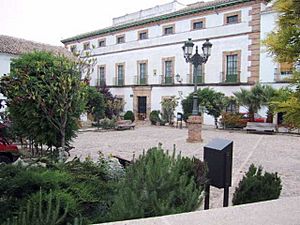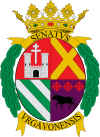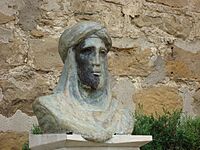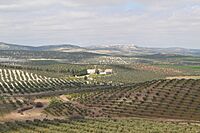Arjona, Spain facts for kids
Quick facts for kids
Arjona
|
||
|---|---|---|
|
Municipality
|
||

Plaza Serrano, Arjona
|
||
|
||
| Country | ||
| Autonomous community |
||
| Province | ||
| Comarca | Campiña | |
| Judicial district | Andújar | |
| Area | ||
| • Total | 154.45 km2 (59.63 sq mi) | |
| Elevation | 458 m (1,503 ft) | |
| Population
(2018)
|
||
| • Total | 5,595 | |
| • Density | 36.225/km2 (93.823/sq mi) | |
| Demonym(s) | Urgabonense or Arjonero/a | |
Arjona is a town in the province of Jaén, Andalusia, Spain. It is about 44 kilometers (27 miles) from Jaén, the capital city of the province. The city of Córdoba is about 77 kilometers (48 miles) away.
Arjona covers an area of about 158 square kilometers (61 square miles). In 2017, around 5,662 people lived there. The town is part of a region called Campiña. Most of the land is used for farming, especially for growing olive trees.
The economy of Arjona mainly depends on farming and making olive oil. However, it is also known for its furniture and baking businesses. Arjona is famous as the birthplace of Muhammad I in 1194. He was the person who started the Emirate of Granada.
Contents
A Look at Arjona's Past
How Far Back Does Arjona's History Go?
Digging in Arjona's main square showed that people lived there around 3000 BC. This was during the Bronze Age. Later, people from Phoenicia and Greece also visited this area. The name URGABON was even found on old Greek coins.
Arjona During Roman Times
When the Romans were in charge, Arjona was called Urgavo or Urgao Alba. In 45 BC, Julius Caesar won a big battle called the Battle of Munda. Arjona had supported Caesar, so it received special rights. Other towns like Illiturgis, Isturgis (now Andújar), and Obulco (now Porcuna) also got these rights.
Old writings show how important Arjona was during the Roman Empire. This was likely because it had temples for important figures like Augustus and Plotina. Arjona was one of the first places in Spain to get Roman citizenship. This meant its people had the same rights as Roman citizens. In 308 AD, two Christian brothers, Saints Bonosus and Maximianus, were executed in Arjona.
Arjona Under Islamic Rule
After the Umayyad conquest in the 8th century, Urgavo became known as Qal'at Arjuna in Arabic. It was controlled by a family called Banu Bayila. When the Caliphate of Córdoba fell in 1031, the city was involved in local conflicts. During this time, its city walls were made stronger. Around the mid-1100s, the Almohad Caliphate took control of Arjona.
The Birthplace of a Kingdom Founder
In 1195, Muhammad ibn Yusuf ibn Nasr was born in Arjona. He was also known as Ibn al-Aḥmar. He later became Muhammad I, the first ruler of the Emirate of Granada. He also started the Nasrid dynasty. He was born in a place called the Alcázar, which is now the Hospital of San Miguel. It used to be known as the Casa del Rey, or "King's House."
After 1212, the Almohad Caliphate became weaker. Al-Andalus then came under the control of Ibn Hud. In 1232, Muhammad started a rebellion in Arjona against Ibn Hud. Muhammad lost the rebellion, but he managed to keep control of Arjona and Jaén. Over the next few years, he took control of several other cities.
Arjona Becomes Christian
In 1244, the Christian forces of Ferdinand III of Castile took Arjona. By 1246, Muhammad agreed to give up Jaén as well. He also accepted Ferdinand as his overlord. This led to the creation of the Emirate of Granada, which was a state that paid tribute to Castile. Muhammad became its first ruler.
After becoming Christian, Arjona and Jaén became part of the Kingdom of Jaén. This was a territory of the Crown of Castile. At first, the Knights Templar managed Arjona. But this group was dissolved in 1312. After that, the Order of Calatrava knights took over.
See also
 In Spanish: Arjona (Jaén) para niños
In Spanish: Arjona (Jaén) para niños







